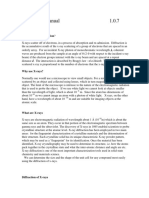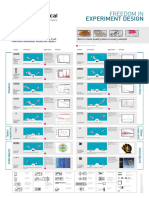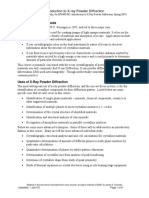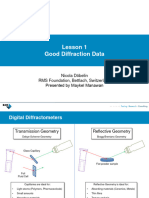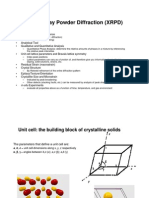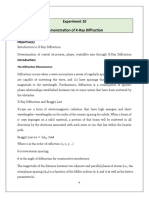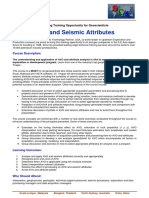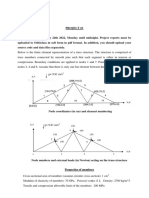1/10/2024
Diffractometer Method
Diffractometer is an instrument for studying crystalline
materials by measurements of the way in which they diffract
(scatter) x-rays of known wavelength.
• Nowadays, diffractometers are used for XRD analysis of
polycrystalline materials
• Diffractometers are convenient and efficient (computer
controlled)
• Suitable method for materials work
• No special sample preparation required
• Crystal Monochromatic is used to eliminate all wavelengths but
the Kα
Dr. Mohsin Ali Raza
Diffractometer Method
Diffraction Camera
Diffractometer
• Diffracted beam is
measured through the • Diffracted beam is
amount of blackening it measured directly by
produces on a an electronic x-ray
photographic film detector
(amount of blackening
is converted into x-ray
intensity).
Dr. Mohsin Ali Raza
Diffractogram
1
� 1/10/2024
Diffractometer
Dr. Mohsin Ali Raza
Diffractometer
Diffraction pattern depends on the kind of circuit used to measure rate of
production of pulses in the detector.
Two ways to measure pulse rate:
1. The succession of current pulses is converted into a steady current,
which is measured on a meter called rate meter, calibrated in counts per
second (cps). Such circuit gives continuous indication of x-ray intensity.
2. The pulses of current are counted electronically in a circuit called scaler,
and the average counting rate is obtained simply by dividing the number
of pulses counted by the time spent in counting.
Scintillation Counter: x-ray photon is absorbed by the scintillator (TI
doped NaI). Scintillator emits visible photon. Visible photon is
converted to electrons. Electron signal is amplified (>10,000 cps are
possible, efficient).
Dr. Mohsin Ali Raza
2
� 1/10/2024
Two ways of measuring diffraction patterns of
an unknown circuit
❑ Continuous scan
Set detector at 2ϴ = 0⁰ and connect to rate meter. The output of this circuit is
fed to a strip-chart recorder. The detector moves at increasing values of 2ϴ
until whole range is scanned.
The paper chart moves at constant speed, so that distances along the length
of the chart are proportional to 2ϴ. Now, completely computer controlled.
❑ Step Scan
The detector is connected to scaler and set at a fixed value of 2ϴ for a
sufficient time to make an accurate count of the pulses obtained from the
detector. The detector is moved to a new angular position and the operation
repeated. The curve of intensity vs 2ϴ consists of series of discrete
measurements.
Step scan is normal mode of operation nowadays.
Dr. Mohsin Ali Raza
Sample Preparation for Powder Diffraction
• Powder diffraction is not limited to only powders, any polycrystalline
material (films or strip) can be used.
• Metals and alloys can be converted into powder by filing or grinding.
• Powder should be finely ground (10 µm or pass through 325 mesh
screen) and randomly oriented.
• Powder should be annealed in order to relieve strains produced due
to filing or grinding. No need of annealing for ceramics or minerals
due to their brittleness.
• Special precaution for two phase alloys ( one phase is more brittle
than other)
• Polycrystalline wires or fibres can be used directly, but since they
exhibit preferred orientation , the resulting diffraction pattern must be
interpreted carefully.
• Powder may be mixed with binder to prevent it falling out of the
sample holder.
• Deposit powder in shallow well of a sample holder. Use slightly rough
flat surface to press down powder to avoid preferred orientation
Dr. Mohsin Ali Raza
3
� 1/10/2024
Bragg Brentano Diffractometer
A detector and sample are moved
so that detector is always at 2ϴ
and the sample surface is always at
ϴ to the incident x-ray beam. This
geometry is called ϴ-2ϴ.
One variant is ϴ-ϴ diffractometer
where sample remains stationary
and x-ray source and the detector
rotate (suitable for thin film
analysis)
Soller slits (A in Fig.) is used to limit spread of the beam from the source
Dr. Mohsin Ali Raza
Bragg Brentano Diffractometer
Theta-2 Theta
Geometry
Tube stationary,
sample moves by ϴ
and detector 2ϴ
Dr. Mohsin Ali Raza
4
� 1/10/2024
Bragg Brentano Diffractometer
Theta- Theta Geometry
Sample stationary,
tube and detector
moves simultaneous
through ϴ.
Good for loose
samples
Dr. Mohsin Ali Raza
Bragg Brentano Diffractometer
Thin Film Scans
Dr. Mohsin Ali Raza
5
� 1/10/2024
Bragg Brentano Diffractometer
Thin Film Scans
Dr. Mohsin Ali Raza
Bragg Brentano Diffractometer
Dr. Mohsin Ali Raza
6
� 1/10/2024
Bragg Brentano Diffractometer
Dr. Mohsin Ali Raza
Bragg Brentano Diffractometer
Focusing Circle
Bragg Brentano instrument operates in a “parafocusing” mode. The
incident and diffracted beam slits move on a circle that is centred
on the sample.
Divergent x-rays hit the sample at different points on its surface.
During the diffraction process through angle 2ϴ, they are refocused
at detector slit.
Dr. Mohsin Ali Raza
7
� 1/10/2024
Bragg Brentano Diffractometer
Soller slits are used to limit the angular divergence or spread of x-
ray beam while allowing it be quite large.
Soller slit contains set of closely spaced, thin metal plates parallel to
the plane of the diffractometer.
Size of slit (L= 32 mm, T = 0.05 mm and gap between plate = 0.43 mm)
Dr. Mohsin Ali Raza
Bragg Brentano Diffractometer
Soller Slits
Beta Filter
Dr. Mohsin Ali Raza
8
� 1/10/2024
Bragg Brentano Diffractometer
Receiving slits defines the width of the beam admitted to the
detector. An increase in width will increase the maximum intensity of
any diffraction line being measured but at the expense of some loss
of resolution.
• The sizes of slits determine the intensity
of peaks measured in diffraction pattern
and also their shapes.
• Narrow slits produce sharper peaks but
reduce intensity
Dr. Mohsin Ali Raza
Bragg Brentano Diffractometer
Divergence Slit
Fitted in the path of incident beam to control the divergence of
the incident beam, and thus the irradiated length of the
sample
Collimators
Used to narrow a beam of particles or waves
Dr. Mohsin Ali Raza
9
� 1/10/2024
Bragg Brentano Diffractometer
Divergence Slit
Dr. Mohsin Ali Raza
Experimental Consideration during diffraction
Varying irradiated area of sample
• Area illuminated (irradiated) is influenced by incident angle and
divergence angle of x-rays
• At low angles beam might be wider than sample (beam spill-off)
• Problems arises if sample is not homogeneous
• The change in irradiated area as incident angle varies is compensated for
by the change in the penetration depth ( area decreases, depth increase
(volume remain constant for polycrystalline material (infinite thickness))
Dr. Mohsin Ali Raza
10
� 1/10/2024
Experimental Consideration during diffraction
Ways to Control irradiated area of sample
Dr. Mohsin Ali Raza
Experimental Consideration during diffraction
Fixed Divergence Slits
PDS
Dr. Mohsin Ali Raza
11
� 1/10/2024
Experimental Consideration during diffraction
Effect of Receiving Slits
Dr. Mohsin Ali Raza
Experimental Consideration during diffraction
Bragg Brentano Para-focusing Geometry
• Geometry ensures divergent beam reconverges at focal point of detector
and this produces sharp well defined peak in data.
• If sources, detector and sample are not all on the focusing circle, error
will appear in the data.
• Parallel beam optics completely eliminates all sources associated with
the focusing circle.
Dr. Mohsin Ali Raza
12
� 1/10/2024
Experimental Consideration during diffraction
Bragg Brentano Para-focusing Geometry
• This geometry offers the advantages of high resolution and high beam
intensity
• The source-to-sample distance be constant and equal to the sample-to-
detector distance.
• Alignment errors often lead to difficulties in phase identification and
improper quantification.
• Polycapillary collimating optics convert a highly divergent beam into a
quasi-parallel beam with low divergence. They can be used to form a
Parallel Beam XRD instrument geometry which greatly reduces and
removes many sources of errors in peak position and intensity inherent
to the parafocusing geometry, such as sample position, shape,
roughness, flatness, and transparency.
Dr. Mohsin Ali Raza
Experimental Consideration during diffraction
Dr. Mohsin Ali Raza
13
� 1/10/2024
Experimental Consideration during diffraction
Sample displacement error
• When samples is not lying on the focusing circle, x-ray beams do not
converge at the correct position for the detector. The peak position
would be incorrect. This is major source of error in the data.
Shift in 2ϴ due to sample height
Type equation here.
Solution:
• Careful preparation of sample and use of
proper sample holder
• Use zero background sample holder
• Use parallel
Dr. Mohsin Ali Razabeam optics
Experimental Consideration during diffraction
Sample Transparency error
• X-rays penetrate into the sample (penetration depth depends on mass
absorption coefficient and incident angle of x-ray beam)
• X-rays are diffracted from various location of the sample (produces peak
position errors and peak symmetry)
• Greater for organic and low atomic number samples
Solution:
• Can be eliminated using parallel beam optics
• Can be reduced using thin samples
• Use zero background sample holder
Dr. Mohsin Ali Raza
14
� 1/10/2024
Experimental Consideration during diffraction
Sample Flatness error
• An exact flat sample does not completely lie on the focusing circle, this
produces asymmetric broadening at low 2ϴ values.
Solution:
• Broadening can be reduced using small
divergence slits
• Make beam length small and increase width
Dr. Mohsin Ali Raza
Diffraction Pattern
• A plot of 2ϴ⁰ vs intensity (cps).
• For crystalline material it shows peaks and for non crystalline a
broad hump.
Dr. Mohsin Ali Raza
15
� 1/10/2024
Diffraction Pattern
• The scattering of x-rays produces a diffraction pattern, which
contains information about atomic arrangement within the crystal.
• A plot of 2ϴ⁰ vs intensity (cps).
• For crystalline material it shows peaks and for non crystalline a
broad hump.
Dr. Mohsin Ali Raza
Diffraction Peaks
• The diffraction peaks gives us information about the planes of
atoms.
Do they tells us about crystal structure, atomic positions, phases,
impurities, orientation? (On casual inspection not, but all these
information can be obtained indirectly form XRD patterns)
Observed diffraction peaks are related to planes of atoms to
assist analysing atomic structure and
Dr. Mohsin Ali Raza microstructure of a sample
16
� 1/10/2024
Diffraction Peaks
Dr. Mohsin Ali Raza
Detectors used in XRD equipment
Types of Detectors
• Si(Li) detector
• Proportional counter
• Scintillation detector
Dr. Mohsin Ali Raza
17
� 1/10/2024
Types of Detectors
• Proportional Counter
• Can distinguish energies of different energy levels.
• Ideal for measurement of longer wavelength, but it is insensitive to wavelengths
shorter than 0.15 nm
• Suitable to detect diffraction patterns from low atomic number elements.
Dr. Mohsin Ali Raza
Types of Detectors
• Si(Li) detector
• to analyze the energy spectrum of incoming
radiation, providing detailed information
about the elemental composition of a
sample.
• used for examining the crystallographic
structure and composition of materials.
• Si(Li) detectors are robust and do not • Si(Li) detectors offer excellent energy
require cryogenic cooling. This resolution, allowing for the precise
simplifies their operation and measurement of the energy levels of
maintenance compared to some detected X-rays or gamma rays.
other types of detectors.
Dr. Mohsin Ali Raza
18
� 1/10/2024
Types of Detectors
• Scintillator detector
Tl doped
Ce-sb
• Blue photons with wavelengths 410 nm are produced
• No of blue photon is related to energy of incident x-ray photon
• Photons produce electrons and current produced by PMT is converted to voltage
pulse
Dr. Mohsin Ali Raza
Pulse Height distribution of three kinds of detectors
Dr. Mohsin Ali Raza
19


